
Marketing ROI – How to measure your campaigns like a pro

Companies spend trillions of dollars on marketing every single day. No matter how many accomplished CMOs build the case for marketing, marketing’s reputation is often that of a cost center rather than a profit-driver.
The only solution to this is adequate planning and measurement. How well you can measure and justify your marketing spend is the difference between a profitable investment and a money-sink.
That’s where Marketing ROI comes in. Instead of investing in marketing channels based on gut feeling, Marketing ROI helps measure the success and returns of your marketing campaigns in totality.
What’s marketing ROI really about?
Marketing ROI, or MROI for short, measures the return on marketing investment within an organization.
In simple terms, MROI is the measurement of the revenue generated from a company’s marketing spend, which varies from one organization to another and could encompass everything from overhead, salaries, media buys, creative services, and more.
The ultimate goal of every marketing operation is to accurately measure every dollar that goes in and the revenue generated from that investment. What was once largely a guessing game, digital marketing today has allowed marketers to more precisely measure what their marketing costs are and how much revenue they’re generating from those efforts in return.
Why is MROI so important? As a general rule of thumb, successful marketing organizations are driven by data, and a firm grasp on attribution, fraud, and misattribution — all contribute to profitable marketing performance.
MROI vs ROAS – The acronyms that keep on giving

Another common (and highly strategic) metric marketers use is ROAS, which is short for Return on Ad Spend. ROAS measures total revenue generated per advertising campaign’s dollars spent. Marketers may interchangeably use MROI and ROAS, but there’s one clear distinction to separate the two.
Calculating ROAS is much more specific in scope, measuring only costs associated with one certain campaign. MROI, on the other hand, provides a higher-level POV of how your overall marketing campaigns are impacting your company’s profitability.
Why is marketing ROI so important for marketers?
MROI provides a high-level view of the performance of your marketing efforts, which offers a few key benefits:
- It helps justify marketing spend
- It can be used as a leading indicator of marketing performance and profitability by executive leaders
Although MROI certainly isn’t the holy grail of marketing KPIs, it holds marketing teams accountable by tangibly measuring the impact of marketing on a company’s bottom line, which prompts marketers to think deeply about how they’re allocating their time and money.
When calculated accurately, MROI ultimately serves as a north star for long term strategic planning. It sheds light to what channels to invest in, how to allocate budgets, who to hire, and track spending levels over time.
Let’s math it up – 3 steps to measuring your marketing ROI
In the simplest terms, marketing ROI can be calculated with the following formula:
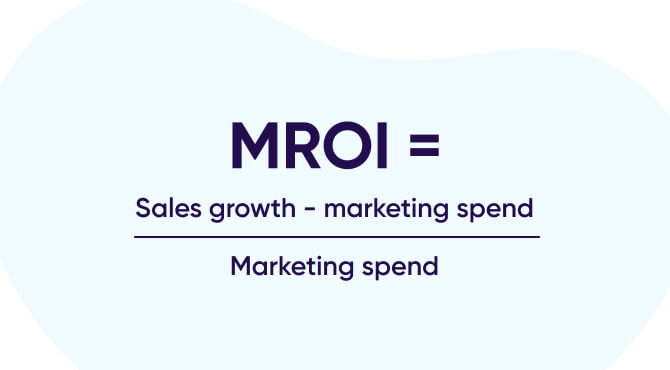
The trickiest part is defining what total marketing spend is and what sales growth actually means. Here’s what you can do to ensure you get the numbers right:
Step 1: Determine your KPIs
Every business is different and marketing ROI cannot be measured by a single metric. In order to justify your marketing budget, use multiple metrics relevant to your campaign’s goals.
So, the first step to measuring MROI is to identify the KPIs that are most valuable to your business. A few examples include:
- Cost per lead (CPL)
- Customer acquisition costs (CAC)
- Customer lifetime value – LTV
- Conversion rates
- Average order value (AOV)
- Purchase frequency (PF)
- Customer average lifespan (CAL)
Step 2: Identify your attribution model
Marketing attribution is about identifying which marketing touchpoints lead to a conversion. Understanding which touchpoints play the largest role in driving a conversion, will help determine what channels, campaigns, and factors contribute the most to your bottom line.
Attribution models can include:
- First touch attribution: first touchpoint receives 100% credit
- Last touch attribution: last touchpoint receives 100% credit
- Time decay: touchpoints closer to conversions receive more credit
- Linear: all touchpoints receive equal credit
- Multi-touch attribution: taking multiple touchpoints into account, and then assigning credit to each based on varying logic per business
Step 3: Determine what metrics to measure
There is no single number that determines a good MROI. That can depend on several factors — including:
- Market conditions
- Stage of your business
- Stage of your marketing campaigns
- Your unique KPIs
- Revenue goals
Hubspot calculates MROI by using the formula:
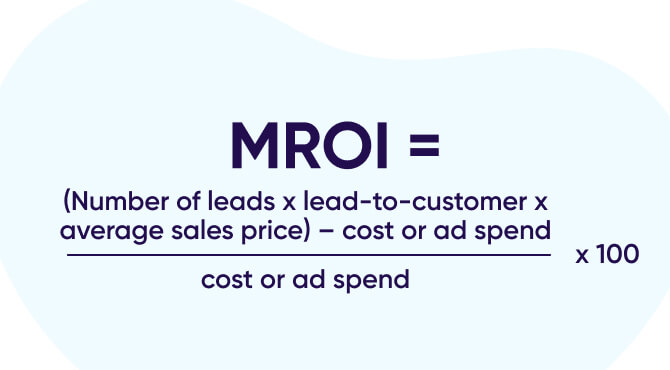
In contrast, another organization may use the following formula to calculate MROI:
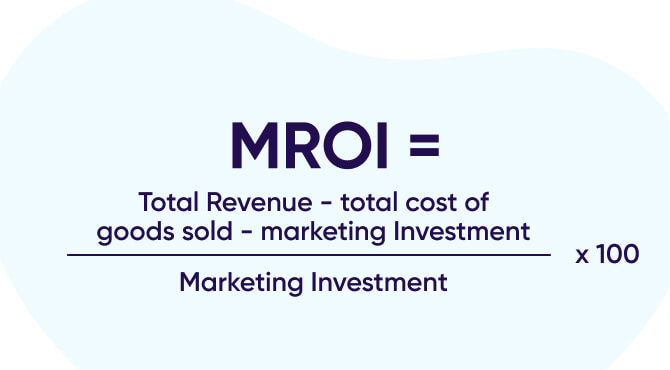
Or, perhaps Customer LTV is the most important metric to their business:
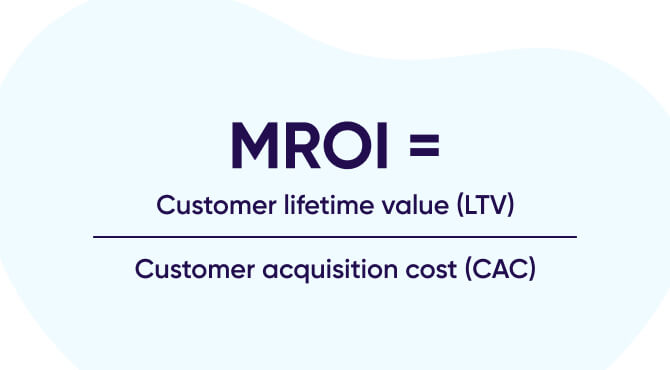
At the end of the day, you need to use the metrics that matter the most to your business and supplement your MROI calculations with contextual data — to be able to paint a full picture of your marketing returns.
A good marketing ROI – Is that even a thing?
As evident from the chapter above, MROI is too subjective and unique to each individual business for there to be a golden ratio that indicates a good MROI.
Instead, marketers should focus on having clean and accurate data, identify their key metrics, and calculate their entire marketing performance according to their unique customer needs and behaviors.
And now that we’ve covered the good stuff, let’s take a look at a few roadblocks on the path to accurate and actionable business insights:
It’s not all peaches and cream – The main challenges of marketing ROI

In theory, MROI should paint a holistic picture of an organization’s marketing performance.
However, even with great strides in attribution technology, there are some common challenges that lower MROI’s efficacy. It oftentimes can be elusive, and marketers don’t realize their calculations are largely inaccurate or incomplete.
Here are the 4 most common reasons why:
1 – Inaccurate data sources
One of the most prevalent challenges for marketers measuring MROI is inaccurate attribution.
Regardless of how sophisticated your BI team is, to have actionable insights you need to measure the right parameters. Having confidence in your numbers comes from reducing and minimizing fraud and misattribution, which means partnering with a trusted MMP and utilizing predictive modeling.
2 – Not incorporating labor
Many marketers only calculate the cost of advertising in their MROI campaigns. To measure more accurately, you need to incorporate all the factors from ideation, strategy, creative, execution, and reporting.
That means not only measuring how much you spent to place an ad, but also measuring the cost of end-to-end campaign management, including your full-time employees and the designers who crafted your advertising campaigns.
3 – Devaluing brand marketing
MROI could encourage narrowing the lens around short-term results instead of taking into account the long-term value of building brand equity.
Brand recognition is critical especially in highly competitive marketplaces where market differentiation is key. When the primary metric is the number of sales and not taking into account sales cycles and LTV, MROI could lead to short-term decision making.
4 – Not looking at other data
MROI should only be a portion of the whole marketing equation. Business decisions should never be made strictly looking at MROI, which like every other marketing metric, needs to be supplemented with contextual information such as market factors, competition, and the stage of the company.
One example is the effect of privacy laws like Apple’s App Tracking Transparency (ATT) policy, which has caused advertising costs to skyrocket. While your campaigns may still be performing well relative to the market, it might still hurt your MROI calculations.
Oftentimes, marketing efforts don’t begin with a positive ROI from the get-go. And if you’re starting from scratch, Search Engine Optimization (SEO) is a great example where it requires six or more months to see positive results.
Similarly, sometimes you’ll need to invest heavily up front in order to kick your marketing campaigns into gear and build initial momentum.
App marketing ROI
Measuring Marketing ROI is equally challenging as it is fruitful. For app marketing in particular, marketers need to take a unique approach to calculate ROI.
Here are a couple of hiccups that make it challenging for app marketers to measure MROI:
Cost data is fragmented
An app marketer’s biggest challenge is getting accurate cost data while having to collect data from a wide variety of sources. No two sources report data exactly the same way, at the same frequency or granularity.
For example, how do you weigh the cost of a tweet from Twitter versus Facebook page likes or Snapchat’s swipe ups? Cost data in the app ecosphere is extremely fragmented and lacks standardization.
This gets even more complicated with ATT, where marketers need to gather data from multiple sources. This includes aggregated deterministic data from SKAdNetwork, user level data from ATT consenting users, aggregate data from probabilistic modeling, and more.
The solution is therefore to work with an MMP provider that collects, organizes, and standardizes all cost reporting using multiple methods of collection.
Some app marketers don’t know their true ROI
There are some marketers who have no idea what their true ROI is, primarily because of heavily distorted data due to sophisticated fraud and false attribution. This results in millions and even billions of dollars in losses, which we call “the bleeding cash cycle”.
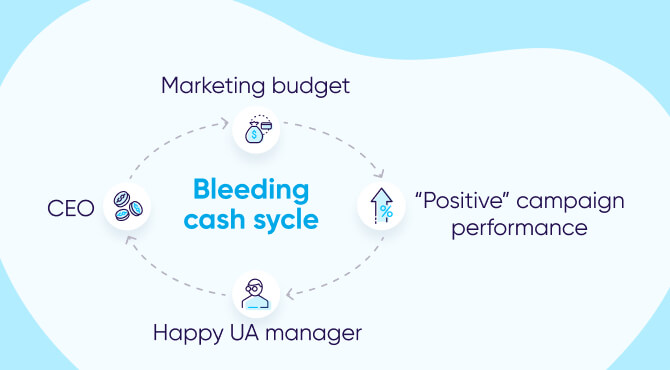
When fraud infiltrates your data, your calculations are irrelevant and unusable. It wastes your time and resources, and ultimately puts you three steps behind with no insights to work with.
Let’s get down to business – 3 steps to measuring your app marketing ROI
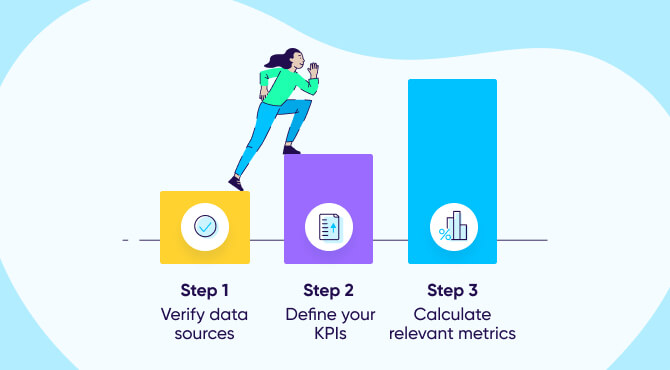
Step 1: Verify your data sources
As mentioned above, the very first step is to ensure your data sources are clean and fraud-free. After partnering with a trusted MMP, commit to verifying your data sources to ensure that your calculations are both accurate and actionable.
Step 2: Define your KPIs
Measuring app marketing ROI is more complicated than dividing revenue by marketing spend. Given there are so many variables depending on the type of app you’re marketing, a plug-and-play formula for calculating your app marketing ROI is simply not an option.
App marketing ROI comes with a level of uncertainty, and to reduce that uncertainty, identify KPIs that tie most directly to your revenue numbers.
Consider using the AARRR (Acquisition, Activation, Retention, Referral, Revenue) framework, which provides goals, signals, and metrics that define the success of your app marketing campaigns.
| Goals | Signals | Metrics | |
| Acquisition | Users understand the benefits and features of your app | • User downloads • Positive social media sentiment • Brand awareness • Increased cross-channel engagement | • Downloads • App store ranking • Cost per acquisition • Cost per install • CPI per campaign |
| Activation | Users complete their desired action | • User in-app activity • Number of onboarded users • Goal completions | • DAU / MAU • Length per session • Goal completions • Cart abandonment |
| Retention | Users return and use your app regularly | • Repeat orders • User frequency • Shorter time between sessions • Increased feature usage | • Churn rate • Session frequency • Session duration |
| Referral | Users talk positively about your app and drive more downloads | • App reviews on app store and 3rd party review sites • Positive press • Increased social media and forum sentiment | • Number of reviews • User invitations • Customer Lifetime Value • Referral retention rates • Install per invite • Net Promoter Score (NPS) |
| Revenue | Users spend money on your app | • In-app purchases • Freemium subscription upgrades • Purchase frequency • Average transaction value | • Average revenue per user • Customer Lifetime Value • Average order value • MRR / ARR |
Step 3 : Calculate the most relevant metrics
Your approach to measuring app marketing ROI is contingent on choosing the most relevant metrics for your app. For example, your ROI can be calculated based on the total value of post-install actions or average revenue per user.
If it’s the latter, you can calculate your app marketing ROI by comparing Average Revenue Per User (ARPU) against CPLU (Cost Per Loyal Customer). If your ARPU is greater than your CPLU, you’ve got yourself a positive ROI!
3 best practices for an MROI-positive 2022
Now that we’ve covered how to measure MROI, here are a few best practices to using your calculations to their fullest potential:
Ensure accurate attribution data
To reiterate, utilizing accurate data is the first and most important step into calculating MROI. By reducing fraud and inaccuracies through a trusted MMP, you minimize mistakes and will be empowered to make critical data-driven decisions.
Avoid vanity metrics and measure what actually matters
Engagement metrics like page views, Facebook followers, and app users is simply not enough to determine the performance of your marketing campaigns. Focus on revenue-tied metrics like customer LTV, average order size, retention rates, and daily active users.
Look at the whole funnel
One of the biggest pitfalls to calculating MROI is working with a limited time frame. When too focused on revenue numbers on a monthly basis, this minimizes the effectiveness of marketing across the entire funnel.
So, when calculating MROI, be sure to take into account how marketing may improve metrics across the whole funnel — such as your retention rates, referrals, and average order values.
Key takeaways
- MROI is the measurement of the revenue generated from a company’s marketing activities, and there’s no single best approach to calculating MROI, as it varies from one organization to another.
- MROI looks at all marketing spend, while ROAS measures the return from specific marketing campaigns.
- MROI helps justify marketing spend, provides a birds-eye view of marketing performance, and aids long-term strategic planning.
- Inaccurate data sources is one of the leading reasons MROI is not an effective metric as it could be, which can be solved by working with an MMP you can trust.
- App marketing ROI is especially challenging, because cost data is fragmented and there is no data standardization across channels.
- To ensure you make the most of your MROI, be sure to rely on accurate data, avoid vanity metrics that offer little value, and always look at your entire funnel (and on the bright side of life!)




